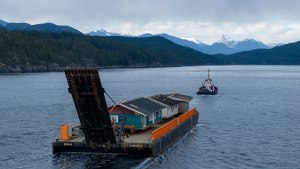One there is a high volume of trucks on roads, concrete wins almost all of the time, says the Ready Mix Concrete Association of Ontario (RMCAO).
One there is a high volume of trucks on roads, concrete wins almost all of the time, says the Ready Mix Concrete Association of Ontario (RMCAO).
In a presentation at the recent Construct Canada conference, Mick Prieur, Senior Pavement Engineer with RMCAO, pointed to an Applied Research Associates Inc. (ARA) study, entitled Methodology for the Development of Equivalent Pavement Structural Design Matrix for Municipal Roadways, which said concrete can handle heavier loads in its life cycle.
The study looked at the maintenance and rehabilitation schedules of concrete versus asphalt and a life cycle cost analysis of each. Study results indicated that Portland cement concrete and hot-mix asphalt performed similarly up to 2,000 trucks a day.
“After about 2,000, the concrete starts taking over and becoming a lot less expensive,” explained Prieur.
There is a big shift in the initial prices of asphalt and concrete.
“The price of oil is so much higher now and oil price is increasing above the inflation rate where concrete price is raising below inflation rate, so as time goes on, concrete is getting much more competitive and asphalt is getting much less competitive,” Prieur said..
The study aimed to develop structurally equivalent pavement designs for municipal roadways in Ontario; develop appropriate maintenance and rehabilitation schedules; and develop a life cycle cost analysis tool to compare whole life costs of pavement alternatives.
“The report really confirmed that the initial construction costs between concrete and asphalt can be very similar,” said Prieur. “Over the long run, concrete is definitely cheaper for maintaining.”
He suggests that municipalities put out a two-component bid for an equivalent cross-section and let the contractors decide which ones they’re going to bid for. He noted that in the American states that have done this, there is usually a three to five per cent reduction in bid prices because more people are bidding for the same work.
He pointed to Iowa where there is a 60 per cent market share in concrete now since they’ve looked into life cycle costing for the state. Canada has about three to five per cent concrete roads.
There are some challenges to using cement; municipalities have become unaccustomed to using it, but there are benefits like fewer maintenance schedules over the life cycle.
“Use some of that budget now for putting in new roads and upgrading those roads because our infrastructure is degrading quicker than we can repair it,” he said. “Our budgets are getting stretched thin so we can stretch is out a bit more by putting in roads that last longer, it will be better for everyone.”
He highlighted the CANPav software, which allows users to compare the short and long-term costs associated with different paving alternatives for various traffic levels and subgrade strengths. One of the most important things to remember, when doing life cycle cost analysis, is to make sure to look at equivalent cross-sections because that’s where inaccuracies come into play, he said.
“You asked them to look at concrete so they just take off 150 millimetres of asphalt, put 230 mm of concrete on it. Concrete is more expensive because they’re not calculating the cost of all the granular materials underneath.”
The attendees of the session had mixed views on some of the practicalities around concrete like the noise and the length of time it takes for concrete to set.
Prieur said a procedure such as diamond grinding has dramatically helped reduce noise and there are always options like precast panels for quick turnaround projects.
But the largest concern was with salt’s affect on concrete roads. Prieur said the study took into account the maintenance schedules for the Ontario Ministry of Transportation and the City of Toronto. An audience member pointed out that the 407 ETR in the Greater Toronto Area is made of concrete and uses the same salt as Highway 401 and that Highway 427 is made of concrete and has been in operation since the 1960s.










Recent Comments
comments for this post are closed